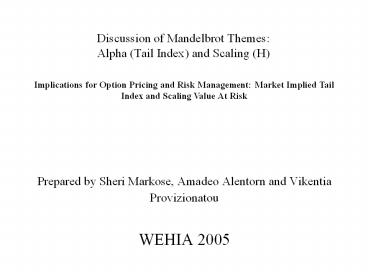Discussion of Mandelbrot Themes: Alpha (Tail Index) and Scaling (H) - PowerPoint PPT Presentation
1 / 23
Title:
Discussion of Mandelbrot Themes: Alpha (Tail Index) and Scaling (H)
Description:
Implications for Option Pricing and Risk Management: Market Implied Tail Index ... VaRq is the q quantile of the portfolio return distribution, and the scaling law ... – PowerPoint PPT presentation
Number of Views:181
Avg rating:3.0/5.0
Title: Discussion of Mandelbrot Themes: Alpha (Tail Index) and Scaling (H)
1
Discussion of Mandelbrot Themes Alpha (Tail
Index) and Scaling (H)
Implications for Option Pricing and Risk
Management Market Implied Tail Index and Scaling
Value At Risk
- Prepared by Sheri Markose, Amadeo Alentorn and
Vikentia Provizionatou - WEHIA 2005
2
PART 1 Market Implied Tail Index and Option
Pricing with the GEV distribution
3
Objectives of the paper
- To use the Generalized Extreme Value (GEV)
distribution in a new option pricing model to - Remove pricing biases associated with
Black-Scholes - Capture the stylized facts of the price implied
RND - Left skewness
- Excess kurtosis (fat tail)
- Obtain a closed form solution for the European
option price - Extract the market implied tail index for asset
returns
4
The GEV distribution
- The standardized GEV distribution is given by
- where
- µ is the location parameter
- s is the scale parameter
- ? is the shape parameter
5
The GEV for different values of ?
6
Density functions for GEV returns
7
The call option closed form solution
- The closed form solution of the call option
pricing equation under GEV returns is - where
- We obtain a similar equation for put options.
8
Methodology of RND estimation
- For a given day, we have a set of N traded option
prices with the same maturity, but different
strikes. - We use a non-linear least squares algorithm to
find the set of parameters that minimize the sum
of squared errors
9
Results Pricing bias (90 days)
- The GEV model removes the pricing bias
- (Price bias Market price Calculated price )
10
Results Pricing bias (10 days)
- For short time horizons, both models improve, but
the GEV model has a smaller error. - (Price bias Market price Calculated price )
11
Results Implied tail index
- Shape parameter ? for put options from GEV
returns 1997 2003
12
RNDs before and after 9/11 events
13
Conclusions
- Modelling negative returns with the GEV yields an
accurate option pricing model, which removes the
pricing biases of the Black-Scholes model. - Implied RNDs and the implied tail index reflect
the market sentiment of increased probability of
downward moves, specially after crisis events,
but do not predict them. - Future work will consist on calculating Economic
Value At Risk from the GEV based RNDs, and
assessing the hedging performance of the model.
14
PART 2 Scaling Value At Risk
15
Scaling VaR for regulatory purposes
- The regulatory standard involves reporting the
10-day Value-at-Risk at 99 per cent confidence
level on trading portfolios of banks. - The current common practice is to use the
daily-VaR, routinely calculated using the banks
internal models, and scale it up to the 10-day
VaR using the square-root-of-time rule. The
latter, which is appropriate for Gaussian
distributions, has been criticized on the grounds
that asset returns data is far from Gaussian.
16
Scaling and self-similarity
- Self-similarity refers to the property that the
increments of X at scale t kv has the same
distribution as any other increment t under
appropriate rescaling. - A stochastic process is self-similar, if there
exists such that for any ,
- H is referred to as the scaling exponent, though
for historical reasons it is also called the
Hurst coefficient.
17
Self-similarity and VaR
- VaRq is the qquantile of the portfolio return
distribution, and the scaling law that applies to
the distribution of returns F(Rk) also applies to
the q-quantile. - From this it follows that the scaling exponent is
18
Empirical scaling for VaR
- The first empirical scaling rule (Hest) assumes a
pseudo scale invariant measure of the scale
exponent, which is derived by the gradient of the
linear regression of the q-quantile of the
returns with different holding periods in a
log-log plot. - The second empirical scaling rule involves the
numerical local determination of scale variant
exponents (Hnum) for the q-quantile one day
returns and the q-quantile of ngt1 returns.
19
Empirical scaling estimated exponent
- Estimated scaling exponents for the FTSE-100
time series at the 1500-days sample (1998-2002).
Results of the regression analysis are presented
for the left tail quantiles ranging from a size
of 0.70 to 0.99.
20
Empirical scaling numerical exponent
- Numerical scaling law results for the 0.99 VaR
(Left Tail) - of FTSE-100. The data sample is 02-01-86 to
03-06-02.
21
Backtesting results reporting violations
- Average Violations reported for the
square-root-of-time rule (SQRT) and the scaling
law exponent (H) at different holding periods (k)
and VaR (left tail) quantiles
22
Backtesting results using charts
23
Conclusions
- Data determined scaling exponents are
time-variant. - Empirical scaling based on both the Hnum and Hest
is significantly different than the
square-root-of-time rule. - The backtesting shows that the application of the
empirically determined scaling rules outperforms
the square-root-of-time rule and leads to a
significant amount of saving in banks capital.































